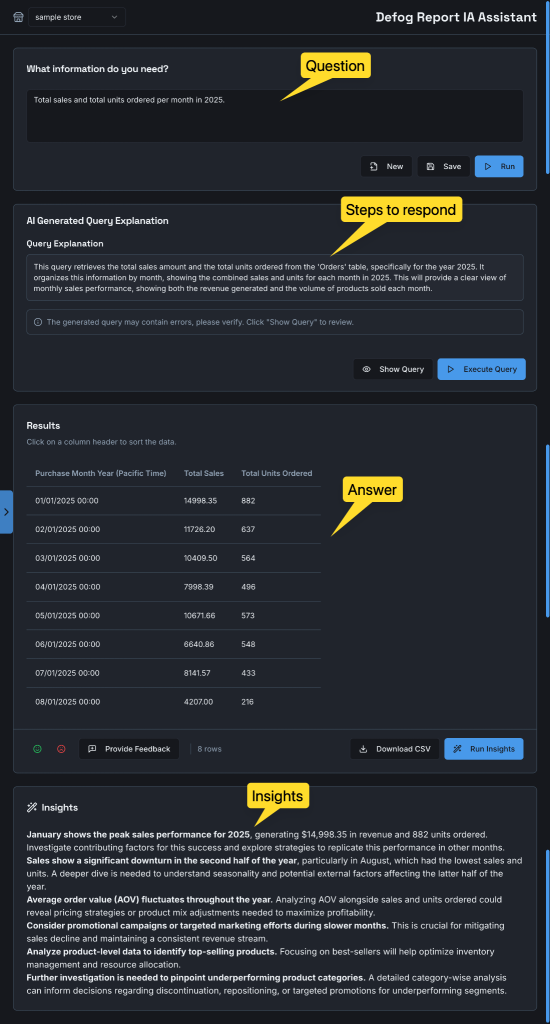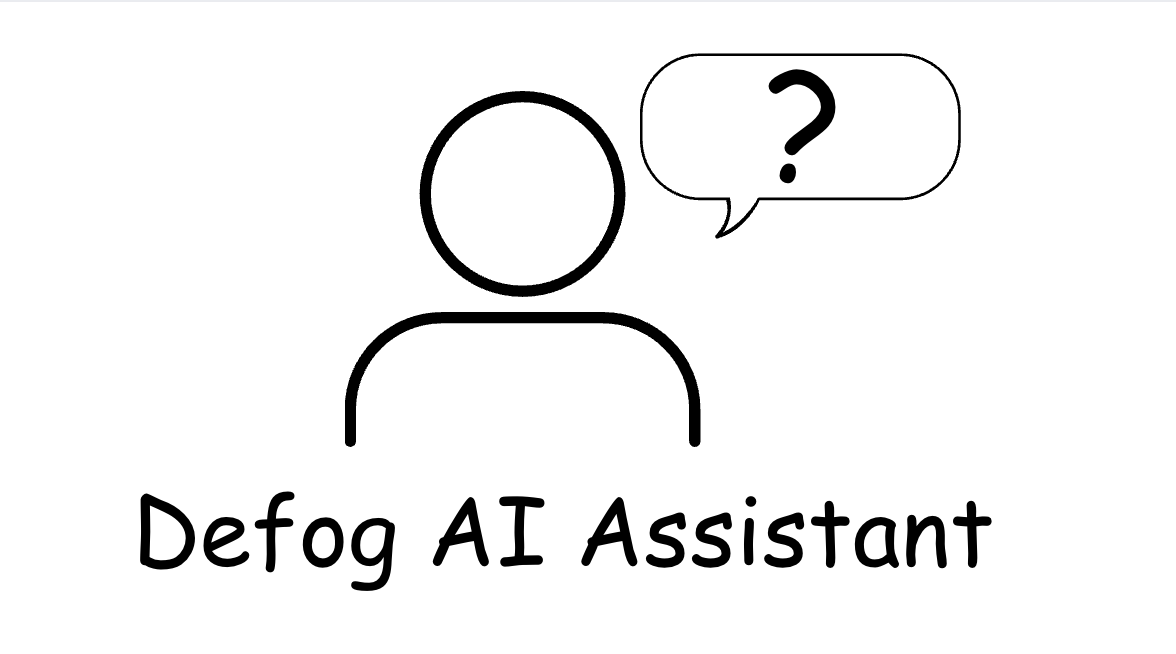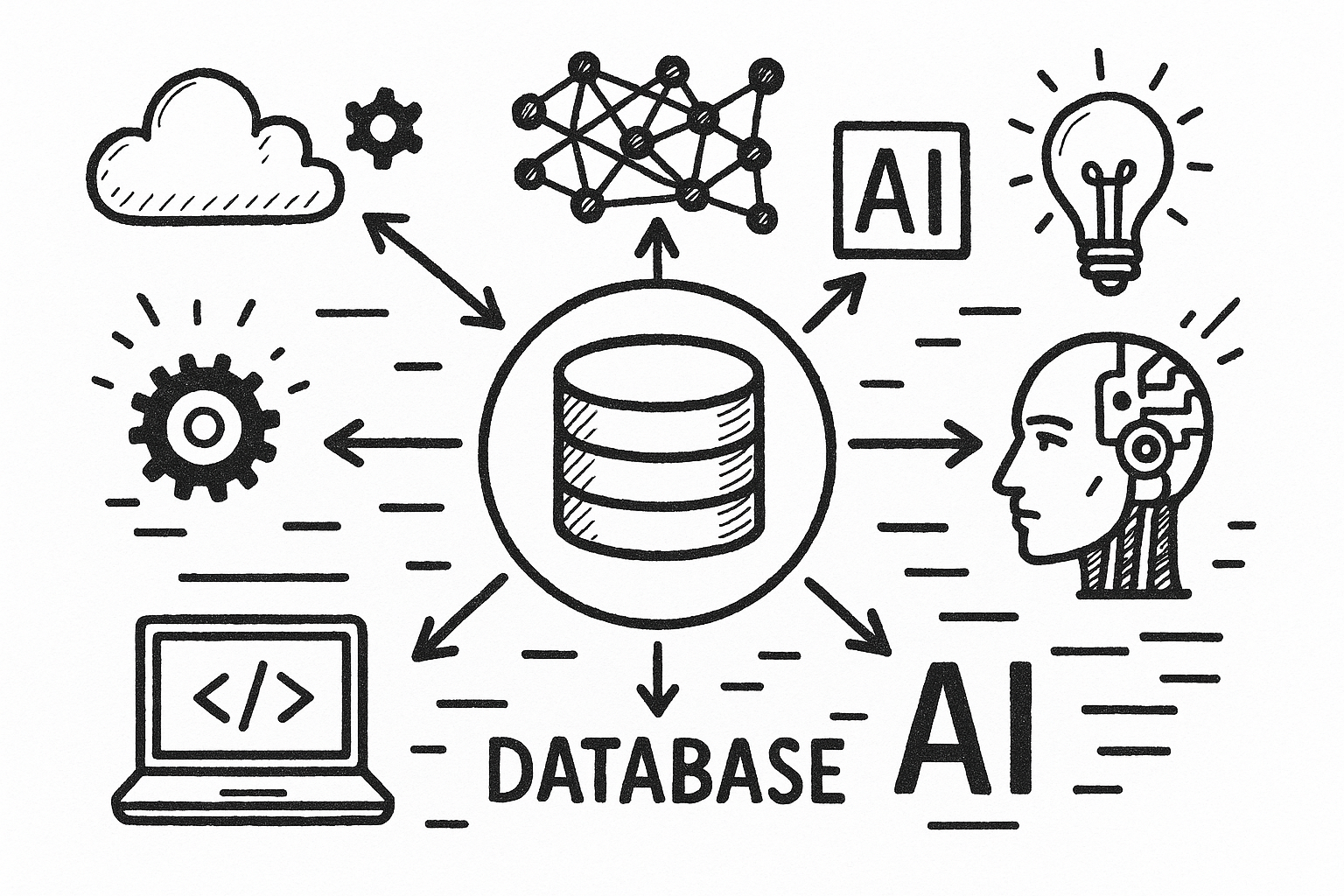For Amazon sellers and agencies, data is the lifeblood of decision-making. Daily fluctuations in market conditions, evolving product offerings, and intense competition demand agility in pricing, advertising, and inventory replenishment. Yet, many sellers and agencies still find themselves reliant on dashboards designed by third parties, like those in Seller Central, that do not answer specific questions or require a dedicated data team to answer those dynamic, ad-hoc questions. Imagine if you could ask your sales or advertising data a question in plain English and instantly receive an accurate, actionable answer or even a customized report. This is no longer a futuristic dream but the present capability of Generative Business Intelligence (GenBI), also called self-serve BI.
What is GenBI?
At its core, GenBI is about how you interact with your data. It leverages advanced Artificial Intelligence (AI), particularly Large Language Models (LLMs), to enable AI-driven analytics through a remarkably effective human interface. Instead of clicking through complex menus, writing SQL queries, or waiting for a data analyst to code something in Power BI, GenBI allows you to converse with your data directly using natural language. This ease of use reassures the audience that they can comfortably adapt to this technology.
Traditional BI tools often necessitate technical expertise (e.g., SQL, DAX, Python) for data manipulation and cleaning to generate pre-defined reports and dashboards. GenBI, however, transcends this by offering a different approach. It understands your business needs and can create dashboards and metrics based on your natural language requests. This means asking, ‘What were my total sales for ASIN B0XXXXXX in the last 30 days, broken down by sales channel?’ and getting an immediate, insightful response, complete with visuals if desired. This unique capability sets GenBI apart, making it a game-changer for Amazon sellers and agencies.
For Amazon businesses, GenBI translates into faster time-to-insight and democratized access to data analytics. It empowers non-technical business users – the sellers and agency account managers themselves – to directly query their performance data, making data analysis more accessible and immediate. The benefits are clear: faster decision-making, reduced reliance on technical data personnel, and the ability to keep pace with dynamic market conditions.
Here’s a look at Defog AI Assistant, a Generative Business Intelligence (GenBI) tool built for Amazon sellers and agencies. Watch this video to see it in action.

The Essential Foundation: BI-as-Code and Semantic Layers
To achieve this powerful conversational capability, GenBI relies on two critical technical foundations: BI-as-Code and Semantic Layers.
BI-as-Code: Defining Your Business Logic as Machine-Readable Code
In the GenBI paradigm, dashboards, metrics, and key performance indicators (KPIs) are defined as code, typically in formats like YAML or SQL. Unlike traditional BI tools that embed business logic within proprietary, opaque user interface configurations, BI-as-Code makes these definitions machine-readable and learnable by AI models.
For Amazon sellers, this means codifying specific business logic:
- Metric Calculations: How is “net revenue” calculated (e.g., SUM(item_price) – SUM(refund_amount))? What about “Advertising Cost of Sale (ACoS)” or “Return on Ad Spend (RoAS)”?
- Data Relationships: How do your Amazon advertising campaigns link to your sales orders to determine conversion rates?
- Visualizations: How are typical performance trends visualized within your company dashboards?
By externalizing these definitions, GenBI can automate the generation of visualizations and analytics. It allows you to maintain complex definitions, facilitating versioning and maintainability of your BI artifacts, also helping a smaller data team (or no dedicated data team) achieve more, as the AI can take care of the heavy lifting of generating queries and dashboard structures.
The Power of the Semantic Layer: Bridging Business Language and Raw Data
While BI-as-Code provides the structural blueprint, the semantic layer provides the crucial business context and meaning that AI needs to understand your data. It acts as a bridge between the language of business (how you describe your Amazon operations) and the technical language of your data (the underlying SQL tables and columns).
A semantic layer organizes and abstracts your complex Amazon store data, enriching it with meaning that both humans and machines can understand, including:
- Data Dictionaries: Plain-language descriptions for every table and column, clarifying terms like item_price as “gross order amount” or last_updated as “the last time inventory was refreshed”.
- Metadata: Information about your data, such as column types, primary/foreign keys (e.g., Amazon_order_id in sales links to customer_id in customer data), and data freshness (e.g., “sales data is updated hourly”).
- Business Rules: Implicit logic not directly in the database, such as “an ‘active customer’ is someone who made a purchase in the last 90 days” or “net profit excludes working capital and loans”.
Why is this critical for GenBI accuracy? The semantic layer can make GenAI answers more accurate by:
- Preventing Misinterpretations: Clarifying ambiguities (e.g., is “sales” gross or net?).
- Guiding Query Generation: Helping the AI pick the right tables, choose appropriate joins, and apply correct filters and aggregations.
- Reducing Hallucinations: By providing a structured, contextual understanding of data, the AI is less likely to generate false or irrelevant information.
For an Amazon seller, a semantic layer ensures that when you ask about “profit,” the AI understands it correctly within your specific business context, pulling from the right tables (sales, refunds, advertising costs) and applying the exact calculations you intend.
GenBI in Action: Solving the Amazon Seller’s Problem
The core data problem for Amazon sellers and agencies is the need for ad-hoc, real-time insights without a dedicated data team, as static dashboards fail to keep pace with dynamic market conditions. GenBI directly addresses this:
- Natural Language Querying (NLQ) for Immediate Answers:
- Direct Interaction: Instead of needing to know SQL, you can type or speak your questions directly into an AI-powered interface. Imagine asking: “Show me the conversion rate for my sponsored product ads in Germany last month for products priced over $50.”
- AI as Your Data Analyst: The GenBI system, armed with the semantic layer, translates your plain-English query into the correct SQL, executes it, and provides the answer, often with additional context.
- Empowering Non-Technical Users: This democratizes data access, allowing sales managers, marketing specialists, and product managers to get the answers they need instantly, freeing them from reliance on technical data personnel.
- Ad-Hoc Reporting and Dynamic Dashboards:
- Beyond Static Views: GenBI can dynamically generate entirely new dashboards or modify existing ones based on your conversational requests. For instance, you could ask, “Create a dashboard showing my top 10 products by sales volume, with a comparison to the previous quarter’s data, and include a drill-down for individual ASIN performance.”
- Iterative Refinement: The system supports iterative refinement. You can ask for an initial dashboard, then say, “Now add a metric for average customer review score for each product,” or “Change the color scheme to reflect our brand guidelines”.
- Narrow to Broad analyses: A dialogue can begin with a precise query, such as “average discount per order from California.” This initial question can then be expanded to generate a complete visual dashboard, transforming a single data point into a broader, explorable perspective. This capability is extremely valuable for identifying trends or anomalies within Amazon data.
- Speed and Agility for Dynamic Markets:
- Real-Time Decision Making: In the fast-paced Amazon environment, delays mean lost opportunities. GenBI aims for instant interactions.
- Eliminating Bottlenecks: This speed bypasses the traditional bottleneck of data teams, allowing Amazon sellers to react swiftly to pricing changes, inventory stockouts, or advertising performance shifts.
Ensuring Accuracy and Trustworthiness in Amazon Marketplace GenBI
For GenBI to be truly valuable for Amazon sellers, the answers must be accurate and trustworthy. Several strategies enhance this:
- Rich Contextual Information: Beyond just schemas, feed the AI with data summaries (e.g., typical sales ranges for a product, average ad spend per day), metadata (e.g., purchase_date is a date type), and the data dictionary (e.g., “RoAS” is “Return on Ad Spend”) helping the model understand typical data ranges, avoid structural errors, and align with your business terminology.
- “Recipe Books” of Examples: Provide the AI with few-shot prompting, i.e., concrete examples of natural language questions paired with their correct SQL queries and desired natural language answers, teaching the AI specific patterns relevant to your Amazon data and query types. For instance, “NLQ: ‘Show top 5 products by revenue this year’, SQL: SELECT asin, SUM(item_price) FROM orders WHERE YEAR(purchase_date) = ‘2025’ GROUP BY asin ORDER BY 2 DESC LIMIT 5;”
- Explicit Business Rules: Document and provide the AI with your unique Amazon business rules, such as “a successful conversion only counts if the order was not returned” or “profit excludes Amazon fees”, ensuring the AI’s answers align with your real-world financial definitions.
- Human-in-the-Loop Feedback: Crucially, GenBI thrives on human-AI collaboration. Implement feedback mechanisms that allow you to approve or correct AI-generated queries and answers. This feedback loop is essential for continuous improvement, as the AI learns from its mistakes and successes over time, refining its “mental map” of your Amazon business.
- Guardrails: Implement automated checks that validate the generated SQL for syntax correctness, table/column existence, and even query cost before execution, catching basic errors and ensuring reliability.
The Future of Amazon Data for Sellers and Agencies
GenBI represents a significant leap forward, making true self-serve BI a reality. For Amazon sellers and agencies, this means:
- Empowerment: You no longer need to be a data scientist or SQL expert to extract deep insights from your complex Amazon data (sales, inventory, advertising, customer reviews).
- Competitive Edge: Rapidly changing market dynamics demand immediate answers. GenBI provides the agility to quickly adapt your strategies for pricing, ad bids, and inventory.
- Unleashed Potential: By bridging the gap between business understanding and raw data, GenBI unlocks the full potential of your Amazon performance data, allowing you to focus on strategic growth rather than data wrangling.
The future of optimizing your Amazon store performance is declarative, contextual, and AI-powered. It promises to reduce manual work, enable faster iterations, and expand the number of people within your organization who can create meaningful BI insights, driving more intelligent decisions and greater success.
Interested in trying Defog AI Assistant or learning more about GenBI for Amazon Sellers and Agencies? Click here to get started.
References:
- “A Primer on Data Governance for a Responsible Artificial Intelligence in the Power Industry”. January 2020.
- www.ai.epri.com
- “BI-as-Code and the New Era of GenBI”. 2024-11-05.
- https://www.ssp.sh/blog/bi-as-code-and-genbi
- “Has Self-Serve BI Finally Arrived Thanks to AI?”. 2025-07-09.
- https://www.ssp.sh/blog/self-service-bi-ai
- “How Semantic Layers Make GenAI 3X More Accurate Than Direct SQL – AtScale”. July 9, 2024.
- https://atscale.com/blog/how-semantic-layers-make-genai-3x-more-accurate-than-direct-sql
- “MIT researchers introduce generative AI for databases | MIT News | Massachusetts Institute of Technology”. July 8, 2024.
- https://news.mit.edu/2024/mit-researchers-introduce-generative-ai-for-databases-0708
- “Semantic Layer and AI: The Future of Data Querying with Natural Language – Cube Blog”. December 19, 2024.
- https://cube.dev/blog/semantic-layer-and-ai-future-of-data-querying-with-natural-language
- “Semantic Layers: When, Why and How to Use Them – Progress Software”. September 17, 2024.
- https://www.progress.com/blogs/semantic-layers-when-why-and-how-to-use-them
- “The Minimum Requirements To Consider Something a Semantic Layer”. February 28, 2025.
- https://www.enterprise-knowledge.com/knowledge-base/the-minimum-requirements-to-consider-something-a-semantic-layer
- “The Role of Semantic Layers with LLMs – Enterprise Knowledge”. April 10, 2024.
- https://www.enterprise-knowledge.com/knowledge-base/the-role-of-semantic-layers-with-llms
- “Top Semantic Layer Use Cases and Applications (with Real World Case Studies)”. May 1, 2025.
- https://www.enterprise-knowledge.com/knowledge-base/top-semantic-layer-use-cases-and-applications-with-real-world-case-studies
This article was written with the help of NotebookLM. https://notebooklm.google.com/ – Google, 2025.





